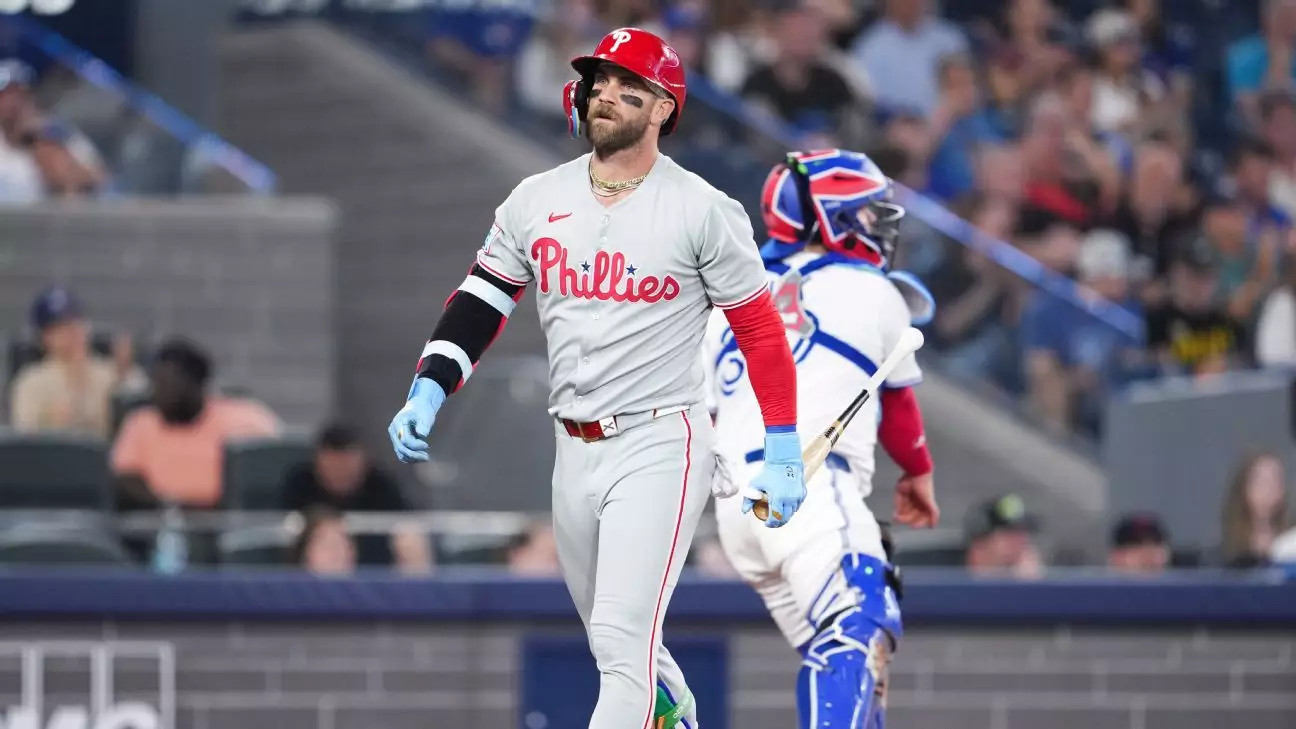Behind Bryce Harper’s impressive batting statistics lies a story of persistence against physical adversity. For a player renowned for his power hitting and athleticism, the chronic inflammation in his right wrist has been an undercurrent affecting his performance since last season. Many might assume a superstar of Harper’s caliber would play only when fully healthy, but his decision to play through the pain highlights the intense commitment and grit required at the highest level of professional baseball. The inflammation didn’t suddenly appear this year; rather, it has hovered in the background, subtly sapping his strength and impacting his game, yet Harper chose to endure and adapt.
Managing Expectations Amid Physical Challenges
Bryce Harper’s recent stint on the injured list wasn’t just a precaution—it was a necessary step toward preventing further damage. But even at the time of his return, it was clear his wrist hadn’t fully healed in a traditional sense. Harper’s own words acknowledge this: he wasn’t necessarily feeling progressively better day by day but rather had reached a plateau of acceptable discomfort. This pragmatic understanding of his physical limits is a rare form of athlete honesty. It underscores how sometimes, professional sports demand operation at less-than-perfect conditions, balancing risk against the need to contribute on the field, especially when the team’s hopes partly hinge on a player of his stature.
Impact on Team Dynamics and Performance
The Phillies’ performance during Harper’s absence paints a nuanced picture. While the team maintained a decent record and held their position atop the NL East, the collective effort couldn’t fully substitue for Harper’s unique playing style and leadership presence. The emergence of Otto Kemp as a capable replacement suggests that the Phillies possess youthful depth, but Kemp’s role is not merely about standing in; it’s about adapting to different strategic needs, such as flexible fielding positions and right-handed hitting prowess. Harper’s presence, even if limited by wrist soreness, is psychologically uplifting and strategically invaluable, which manager Rob Thomson recognizes by emphasizing a day-to-day approach to his involvement.
The Complex Decision of Returning to Play
The pathway back to action for Harper underscores the delicate calculus in professional sports injury management. Instead of a clear “ready or not” scenario, his comeback was about gauging incremental progress and trusting subjective feedback from his own body. The wrist’s response to batting practice and live pitching was consistent enough to justify his return, even without a cure-all improvement. This approach is a double-edged sword: it risks aggravation but allows the player and team to stay competitive. Harper’s openness to the possibility of different roles—such as potentially shifting to designated hitter—reveals flexibility in adapting to his present limitations while maximizing his offensive contributions.
An Enduring Legacy Amid Physical Setbacks
Harper is no stranger to carrying the mantle of high expectations, given his hefty contract and MVP accolades. His role in guiding the Phillies to multiple playoff appearances and a World Series berth cements his leadership status. Yet, his battles with injury humanize him beyond the statistics and awards. It’s a reminder that elite athletes often confront unseen struggles, balancing their personal drive with the physical toll of the sport. Harper’s journey through this wrist issue is emblematic of the less glamorous but crucial side of professional baseball—the continuous negotiation between peak performance and physical vulnerability.
Future Prospects and Team Adaptation
Looking ahead, Harper’s wrist recovery trajectory and playing time will likely remain fluid and carefully monitored. The Phillies’ management must weigh short-term performance boosts against long-term health considerations for their star player. Meanwhile, the emergence of players like Kemp suggests a strategy of building organizational depth to absorb fluctuations in player availability. Philadelphia’s blend of veteran star power and energetic youth could form a blueprint for balancing ambition with durability in a demanding season. For Harper, resilience isn’t just about overcoming pain—it’s about redefining how to contribute effectively in a game that’s constantly evolving around him.

